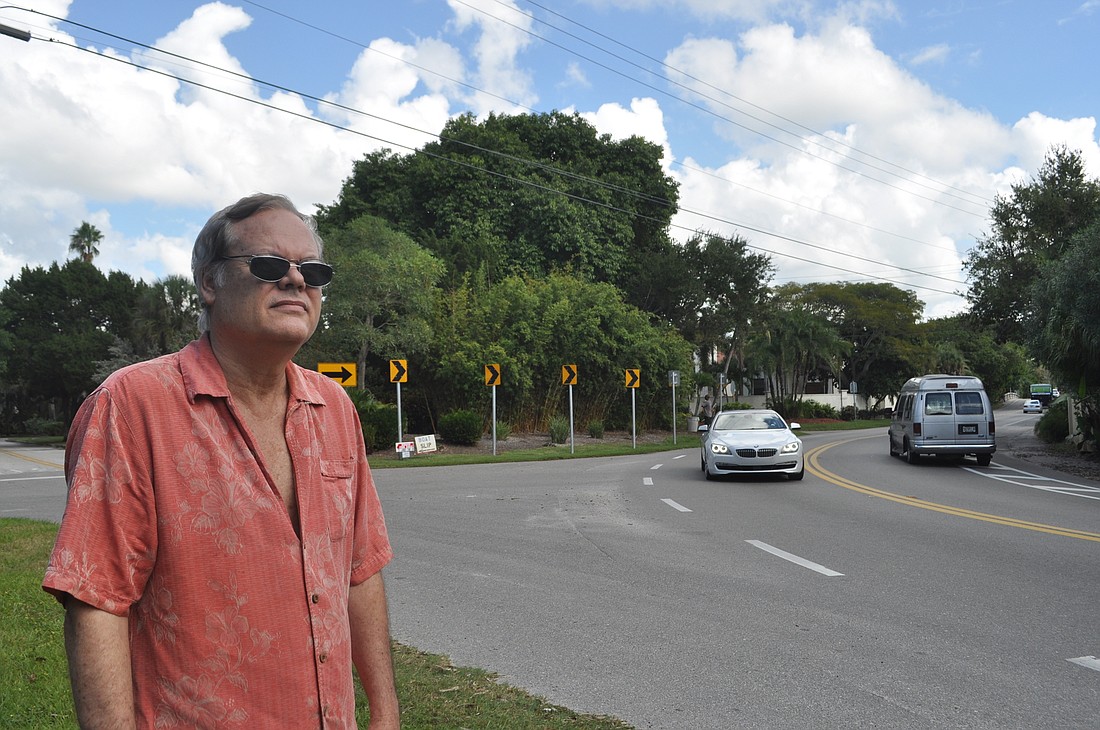- April 25, 2024
-
-
Loading

Loading

When Michael Rushforth saw the Urban Design Studio’s vision for his neighborhood of Bay Island, he was aghast — and things just got worse when he realized nobody had spoken out against it.
As the Urban Design Studio works on writing a new form-based zoning code for the entire city, it has been meeting with individual neighborhoods to gather information and present its findings. In April, the group showed its vision for improving the Siesta Drive and Higel Avenue intersection, which Bay Island residents cited as a problem area.
But no residents of the northern Siesta Key neighborhood attended the April workshop. Rushforth wasn’t aware of the sketches — which included a roundabout and two partially commercial parcels at the intersection — until he saw the Sept. 24 edition of the Sarasota Observer.
Immediately, he thought the proposal was all wrong for the residential neighborhood. He mobilized other residents, who reached out to the studio and affirmed Rushforth’s stance.
“I can tell you: Nobody out here likes it,” Bay Island resident Phil Agnes said of the proposal.
Since 2013, the Urban Design Studio has been working to craft the code for completion in 2016. At an Oct. 29 presentation hosted by the Downtown Sarasota Alliance, Fort Myers-based planner Bill Spikowski said it’s crucial to get buy-in from neighborhoods affected by the new code.
“It’s legitimate for people to be scared about this,” said Spikowski, a board member for the Form-Based Codes Institute. “If you can’t make a compelling argument that it’s good for your neighborhood as well as the whole city, you’re probably not going to get anywhere with it.”
Today, that fear is real in several pockets of the city. In response to ongoing concerns, Urban Design Studio Director Karin Murphy assures residents that everything is subject to change at this point.
She still wants to address issues with the Siesta-Higel intersection, but she’s willing to burn the controversial drawings after hearing resident feedback. She knows the new regulations will touch on sensitive subjects — but it’s her job to move ahead with recommendations she believes will improve the community.
“Everybody likes progress,” Murphy said. “Nobody likes change.”
"Everybody likes progress. Nobody likes change." — Karin Murphy
On St. Armands, prominent figures have expressed concerns about the impact of the new code — and said those concerns are being ignored. At the Oct. 13 St. Armands Business Improvement District meeting, Co-Chairman Marty Rappaport suggested Murphy was making recommendations without regard for the interests of St. Armands stakeholders.
The Urban Design Studio has hosted three events focused on St. Armands this year. In March, the group walked through the residential area to get feedback from neighborhood leaders before presenting their findings and recommendations later that month. In August, the studio held a workshop to get feedback from merchants on sign regulations.
Rappaport rattled off a list of specific problems. The studio suggested implementing individually boxed parking spaces on the Circle — a once-unpopular feature that the city eliminated in 2012. It wanted to install parallel parking along the median of John Ringling Boulevard, which would actually reduce the parking stock on special events weekends.
St. Armands Circle Association Executive Director Diana Corrigan said merchants’ interests weren’t being adequately served.
“St. Armands is different, and they need to recognize that,” Corrigan said. “We know what works, and we know what doesn’t work.”
Murphy, who is working to meet with representatives from every city neighborhood, bristled at the allegation that she was unwilling to listen to resident feedback.
In addition to direct meetings, Murphy has gone through years of feedback regarding certain neighborhoods — such as a 2014 study that suggested the storefronts on the Circle are outdated. What she presents is her attempt at synthesizing the (occasionally conflicting) information she’s gathered.
That’s why she’s suggested reinstituting boxed parking: in an area short on parking spaces, it could be a fast, inexpensive fix. Installing more parking on John Ringling Boulevard would achieve the same goal, and she’s open to making the spaces diagonal rather than parallel.
"St. Armands is different, and they need to recognize that." — Diana Corrigan
In a draft document, a map lists the “St. Armands Business District” as an area subject to its own specially tailored regulations. Murphy said the studio doesn’t want to throw away existing regulations where they work, but they do want to streamline the current code. On St. Armands, that could mean removing certain design guidelines that aren’t enforceable.
“We’re asking those areas and stakeholders — do you want these things?” Murphy said. “Are they important enough to make them standards? If not, we’ll put them somewhere else.”
Murphy encourages residents to communicate their feelings at any point — although she acknowledges there may be points of genuine disagreement.
Ultimately, the code Murphy will present next year is just a series of recommendations to city officials. When it’s complete, she plans to be transparent about what portions received strong resident backing and which were more controversial. Already, she knows the document won’t have universal support.
Until that moment arrives, she continues to invite feedback from all interested parties.
“You try to give the most open, inclusive process you can,” Murphy said. “No matter what you do, you can never win with everybody.”